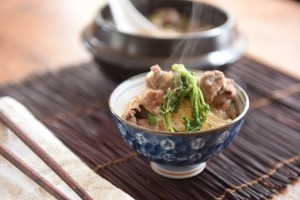 THE OTHER DAY I scouted some of my early morel spots. I came away with something just as good for my effort: wild watercress. Watercress is one of the first spring greens of the season, and depending where you live, it often has a second act in the fall.
THE OTHER DAY I scouted some of my early morel spots. I came away with something just as good for my effort: wild watercress. Watercress is one of the first spring greens of the season, and depending where you live, it often has a second act in the fall.
With a little prepping, this bulgogi stew is easy. It’s essential, however, to marinate the beef for at least an hour beforehand (overnight is even better). I’ve used various marinade recipes for bulgogi and kalbi ribs over the years, including Bittman’s simple version. More traditional recipes call for an Asian pear to help sweeten and tenderize the meat, as in this recipe, although other recipes omit the fruit. As it happens, my local butcher sells thin-sliced beef trimmings already marinated.
A typical clay pot bulgogi will have some sort of leafy green vegetable such as spinach stirred in at the end; this one owes its vibrant color to the wild and very nutritious watercress that’s leafing out across much of the country right now.
1/2 pound marinated bulgogi, preferably thin-sliced ribeye (see marinade recipes above)
1/2 small yellow onion, cut into thin slices (add to marinating meat if desired)
1 cup water
1 cup beef stock or dashi
1 handful cellophane sweet potato noodles, about 5 oz
1 green onion, sliced
1 handful fresh wild greens such as watercress, bittercress, dandelions, lambs-quarters
Other optional ingredients: shiitake or enoki mushrooms, sliced carrots, egg
1. Add cellophane noodles to a bowl of warm water and set aside for 20 minutes.
2. Heat clay pot (or conventional pot) over high heat, then add beef and onions and stir-fry a couple minutes until the meat is lightly browned.
3. Add water and stock. If using a clay pot, leave enough room for noodles.
4. Once boiling, stir in pre-softened noodles and cook until tender.
5. When noodles are ready, stir in wild greens and green onion and remove from heat.
Serves 2 with rice.
